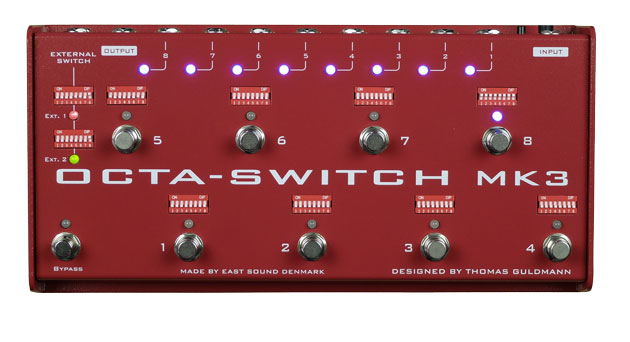 Although the Octa-Switch MK2 still feels fresh in our memory, Carl Martin recently released the MK3, a streamlined edition of the popular MK2. At a street price of around $427, it’s easily the most affordable switcher in our roundup.
Although the Octa-Switch MK2 still feels fresh in our memory, Carl Martin recently released the MK3, a streamlined edition of the popular MK2. At a street price of around $427, it’s easily the most affordable switcher in our roundup.
The MK3 is more pedalboard-friendly than the two previous incarnations—primarily because it utilizes two rows of footswitches, rather than one long row. And while Carl Martin has stuffed a lot of functions into less space, the jacks are still spaced out wide enough to patch in the right-angle plugs used for most pedalboard applications (something I wasn’t able to do with the other two switchers in this roundup).
I was a little surprised when I opened the box and didn’t see a power supply. But the Octa-Switch MK3 is compatible with a standard 9V adapter, and I just daisy chained it to my pedalboard’s existing power supply. (Unlike the MK2, the MK3 can’t be powered by batteries.)
The Octa-Switch MK3 offers eight loops (the last loop is stereo) and eight banks—which should be more than enough for most players. In addition to the eight loop footswitches, there’s a switch for bypassing the unit completely.
The MK3 has a decidedly mechanical, analog feel—largely due to the absence of a readout and the eight dip switches above each preset footswitch. The dipswitches correspond to the eight send/returns and the pedal; you route through them. You determine which pedals make up a given preset by turning the dipswitches off or on. I’m not a huge fan of dipswitches, but here the design is more intuitive, and arguably faster, than scrolling through a small screen. On the top corner of the control panel are eight small blue LEDs that correspond to loops 1-8 and light up to show which loop is activated on a selected preset. There are also two rows of dipswitches for external switching of amp channels or amplifier reverb. These, too, can be assigned to work with a selected loop.
It took me about a minute to program a relatively simple rig consisting of a Mesa/Boogie Trem-O-Verb and several pedals. For a rhythm preset, I used a Boss CE-2 and Ibanez AD-9 going into the amp’s clean channel. For leads, I created two presets—a Mad Professor Bluebird overdrive/delay going into the amp’s clean channel and an Ibanez TS-9 used as a boost going into the amp’s high gain channel. I also used a Boss TU-2 tuner, though, oddly, there is no dedicated tuner out on the Octa-Switch MK3. The presets all worked flawlessly and switching was immediate and pop free.
The MK3 lacks MIDI, the ability to change the order of pedals in a chain, and the ability to switch on individual pedals while running a preset. But while it may lack some of the features that distinguish and add wow factor to the Boss and RJM, I didn’t mind not having those options. If I knew I’d need an additional boost for a lead preset to suit a different playing environment, I’d simply add the boost to an existing preset or program a new one on the spot. It doesn’t take more than a second to flick the dipswitch. Above all else, the MK3 is fast and easy.
Though it may lack some fancy digital features, the MK3 is capable of a lot more than just switching pedals on and off. You can use it as a killer A/B switcher to route two guitars into two separate amps, with each pair attached to its own group of effects. Just bypass the standard in/out controls and patch everything through the loop jacks.
The mechanical simplicity of the Octa-Switch MK3 is a beautiful thing. The intuitive design means neophytes can get started fast without consulting a manual. And it’s simple enough to make troubleshooting a breeze in performance situations. In an era in which many switchers are as complex as some multi-effects units, the MK3’s what-you-see-is-what-you-get layout cuts through all the frivolities. This bad boy lets you just program the configurations you’ll actually need rather than bog you down with hypothetical possibilities you’ll never actually use.
